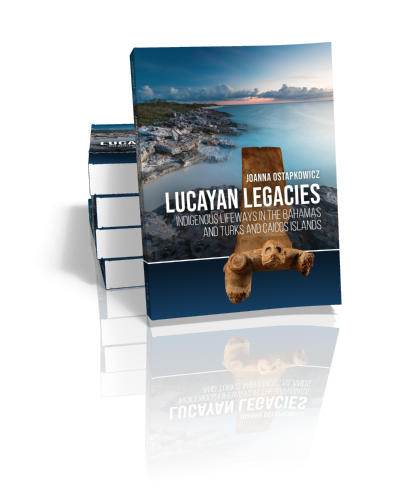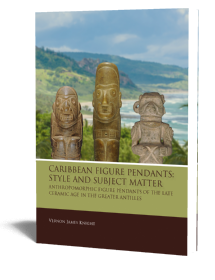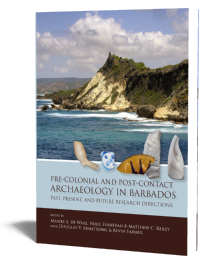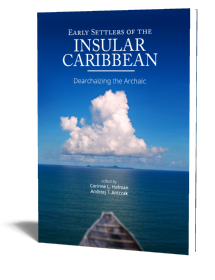Lucayan Legacies
Indigenous lifeways in The Bahamas and Turks and Caicos Islands
Joanna Ostapkowicz | 2023

Lucayan Legacies
Indigenous lifeways in The Bahamas and Turks and Caicos Islands
Joanna Ostapkowicz | 2023
Paperback ISBN: 9789464261011 | Hardback ISBN: 9789464261028 | Imprint: Sidestone Press | Format: 210x280mm | 358 pp. | Language: English | 30 illus. (bw) | 143 illus. (fc) | Keywords: Lucayans; Caribbean archaeology; The Bahamas; Turks and Caicos Islands | download cover
Read online 395 times
- Digital & Online access
-
Buy via Sidestone (EU & UK)
-
Buy via our Distributors (WORLD)
For non-EU or UK destinations you can buy our books via our international distributors. Although prices may vary this will ensure speedy delivery and reduction in shipping costs or import tax. But you can also order with us directly via the module above.
UK international distributor
USA international distributor
-
Bookinfo
Paperback ISBN: 9789464261011 | Hardback ISBN: 9789464261028 | Imprint: Sidestone Press | Format: 210x280mm | 358 pp. | Language: English | 30 illus. (bw) | 143 illus. (fc) | Keywords: Lucayans; Caribbean archaeology; The Bahamas; Turks and Caicos Islands | download cover
Read online 395 times

We will plant a tree for each order containing a paperback or hardback book via OneTreePlanted.org.
This book is about Lucayan legacies – the heritage of the people who made The Bahamas and Turks and Caicos Islands (the Lucayan archipelago) their home from the 8th to the 16th centuries. This legacy is not simply the surviving physical record, consisting of artefacts of stone, shell and wood – it is a history entangled in the early antiquarian and archaeological interests in the region, resulting in the museum and institutional collections both within and beyond the islands. Many of the collections now in museums were acquired between 1850 and 1950, before professional archaeology emerged as a field in the region, and are largely unknown even to many archaeologists working in The Bahamas and the wider Caribbean, let alone to local island communities and the wider public. In drawing together this widely dispersed corpus, this comprehensive, richly illustrated study aims to foreground the material culture of the Lucayans, making it more accessible and reinstating it as an important part of the region’s archaeological heritage.
Development on the islands dating back to the 17th century has resulted in the loss of much of the earlier heritage, with a rate of destruction that has only increased in recent decades as a result of both human activity but also global climate change, seeing rising sea levels and ever-more violent storms. In this context, it is important to take stock of the islands’ surviving Lucayan heritage, and integrate it back into the narratives of the past. Many of the most elaborate artefacts ever found on the islands – including a number of wood carvings – have not been recovered from archaeological excavations, but rather as a result of early guano mining and cave exploration. This has led to them often being marginalised, reinforcing an impression of a comparatively ‘simple’ Lucayan society.
A central tenet of the book is that this impression is mistaken, and that the Lucayans had a rich material culture and were active participants in social, economic and political exchanges with the larger islands of the Greater Antilles. By integrating these legacy collections with a historiography of archaeological investigation in the region, the volume addresses topics ranging from the first occupations on the islands, to an island-by-island review of finds and settlements, and a consideration of Lucayan lifeways. Further, it explores some of the new directions this heritage is taking through the work of contemporary Bahamian and TCI artists.
List of Figures
List of Tables
Acknowledgements
Foreword: Kim Outten Stubbs, Director, National Museum of The Bahamas (AMMC)
Donald H. Keith, Turks and Caicos National Museum Foundation Board of Directors
1. The cultural legacies of the Lucayans
1.1 Lucayan: some definitions
1.2 The setting
1.3 The impact of history on prehistory
1.4 The dispersal of Lucayan cultural heritage
1.5 Local museums, local interest?
1.6 Heritage protection
2. Lucayan prehistory: current understandings
2.1 Chronologies and migrations: Lucayan archipelago in a circum-Caribbean context
2.2 Settlements: the world in one village (or two)
2.3 Socio-political organisation and trade
2.4 Life, death, afterlife
3. Collectors, Collections and the early years of Lucayan archaeology: a brief history (1780-1950)
3.1 Explorations 1850-1900: Frith, Murphy, Blake, Brooks
3.2 Investigations 1900-1959: de Booy, Rainey, Krieger, Goggin, Granberry
3.3 Archaeological investigations from the 1960s onwards: a brief introduction
4. Island archaeologies
4.1 The northern Islands
4.2 The central Islands
4.3 The southern Islands
5. Material culture
5.1 Lucayan ‘art’? Lucayan aesthetics
5.2 Bodies adorned
5.3 The ephemeral arts: fibres and textiles
5.4 A forest for wood carving
5.5 The emergence of Palmetto Ware
5.6 Stone tools: forms, functions and facilitators
5.7 Petroglyphs
6. Histories
6.1 Columbus in The Bahamas: 12 to 27 October 1492
6.2 European trade goods
6.3 The colonial period: charted islands, enslaved bodies
6.4 Lucayan adaption, resistance and persistence
6.4.3 Survivors of the slave raids: Catalinica, Beatrizica and the pearl divers (post-1538)
6.5 Lucayans in national identity
References
Appendix: Lucayan collections in international museums
Index
Dr. Joanna Ostapkowicz
Joanna Ostapkowicz is Research Associate in Caribbean Archaeology at the School of Archaeology, University of Oxford. Her research focuses on bringing a wide span of analytical techniques to better understand the chronological range, materials and provenance of Caribbean artefacts in museum collections. She has been Principal Investigator on several international, multi-disciplinary research projects that focus on Caribbean sculpture and bridge the arts and sciences, including Pre-Hispanic Caribbean Sculptural arts in Wood (supported by the Getty Foundation and British Academy), Black Pitch, Carved Histories: Prehistoric wood sculpture from Trinidad’s Pitch Lake (the Arts and Humanities Research Council [AHRC], UK) and SIBA: Stone Interchanges in the Bahama Archipelago (AHRC).
Abstract:
This book is about Lucayan legacies – the heritage of the people who made The Bahamas and Turks and Caicos Islands (the Lucayan archipelago) their home from the 8th to the 16th centuries. This legacy is not simply the surviving physical record, consisting of artefacts of stone, shell and wood – it is a history entangled in the early antiquarian and archaeological interests in the region, resulting in the museum and institutional collections both within and beyond the islands. Many of the collections now in museums were acquired between 1850 and 1950, before professional archaeology emerged as a field in the region, and are largely unknown even to many archaeologists working in The Bahamas and the wider Caribbean, let alone to local island communities and the wider public. In drawing together this widely dispersed corpus, this comprehensive, richly illustrated study aims to foreground the material culture of the Lucayans, making it more accessible and reinstating it as an important part of the region’s archaeological heritage.
Development on the islands dating back to the 17th century has resulted in the loss of much of the earlier heritage, with a rate of destruction that has only increased in recent decades as a result of both human activity but also global climate change, seeing rising sea levels and ever-more violent storms. In this context, it is important to take stock of the islands’ surviving Lucayan heritage, and integrate it back into the narratives of the past. Many of the most elaborate artefacts ever found on the islands – including a number of wood carvings – have not been recovered from archaeological excavations, but rather as a result of early guano mining and cave exploration. This has led to them often being marginalised, reinforcing an impression of a comparatively ‘simple’ Lucayan society.
A central tenet of the book is that this impression is mistaken, and that the Lucayans had a rich material culture and were active participants in social, economic and political exchanges with the larger islands of the Greater Antilles. By integrating these legacy collections with a historiography of archaeological investigation in the region, the volume addresses topics ranging from the first occupations on the islands, to an island-by-island review of finds and settlements, and a consideration of Lucayan lifeways. Further, it explores some of the new directions this heritage is taking through the work of contemporary Bahamian and TCI artists.
Contents
List of Figures
List of Tables
Acknowledgements
Foreword: Kim Outten Stubbs, Director, National Museum of The Bahamas (AMMC)
Donald H. Keith, Turks and Caicos National Museum Foundation Board of Directors
1. The cultural legacies of the Lucayans
1.1 Lucayan: some definitions
1.2 The setting
1.3 The impact of history on prehistory
1.4 The dispersal of Lucayan cultural heritage
1.5 Local museums, local interest?
1.6 Heritage protection
2. Lucayan prehistory: current understandings
2.1 Chronologies and migrations: Lucayan archipelago in a circum-Caribbean context
2.2 Settlements: the world in one village (or two)
2.3 Socio-political organisation and trade
2.4 Life, death, afterlife
3. Collectors, Collections and the early years of Lucayan archaeology: a brief history (1780-1950)
3.1 Explorations 1850-1900: Frith, Murphy, Blake, Brooks
3.2 Investigations 1900-1959: de Booy, Rainey, Krieger, Goggin, Granberry
3.3 Archaeological investigations from the 1960s onwards: a brief introduction
4. Island archaeologies
4.1 The northern Islands
4.2 The central Islands
4.3 The southern Islands
5. Material culture
5.1 Lucayan ‘art’? Lucayan aesthetics
5.2 Bodies adorned
5.3 The ephemeral arts: fibres and textiles
5.4 A forest for wood carving
5.5 The emergence of Palmetto Ware
5.6 Stone tools: forms, functions and facilitators
5.7 Petroglyphs
6. Histories
6.1 Columbus in The Bahamas: 12 to 27 October 1492
6.2 European trade goods
6.3 The colonial period: charted islands, enslaved bodies
6.4 Lucayan adaption, resistance and persistence
6.4.3 Survivors of the slave raids: Catalinica, Beatrizica and the pearl divers (post-1538)
6.5 Lucayans in national identity
References
Appendix: Lucayan collections in international museums
Index
Dr. Joanna Ostapkowicz
Joanna Ostapkowicz is Research Associate in Caribbean Archaeology at the School of Archaeology, University of Oxford. Her research focuses on bringing a wide span of analytical techniques to better understand the chronological range, materials and provenance of Caribbean artefacts in museum collections. She has been Principal Investigator on several international, multi-disciplinary research projects that focus on Caribbean sculpture and bridge the arts and sciences, including Pre-Hispanic Caribbean Sculptural arts in Wood (supported by the Getty Foundation and British Academy), Black Pitch, Carved Histories: Prehistoric wood sculpture from Trinidad’s Pitch Lake (the Arts and Humanities Research Council [AHRC], UK) and SIBA: Stone Interchanges in the Bahama Archipelago (AHRC).
- Digital & Online access
-
Buy via Sidestone (EU & UK)
-
Buy via our Distributors (WORLD)
For non-EU or UK destinations you can buy our books via our international distributors. Although prices may vary this will ensure speedy delivery and reduction in shipping costs or import tax. But you can also order with us directly via the module above.
UK international distributor
USA international distributor
- Browse all books by subject
-
Search all books

We will plant a tree for each order containing a paperback or hardback book via OneTreePlanted.org.
You might also like:
© 2026 Sidestone Press KvK nr. 28114891 Privacy policy Sidestone Newsletter Terms and Conditions (Dutch)








